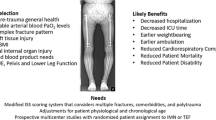Abstract
Purpose
The purpose of this study was to investigate length of stay, postoperative mobilization and discharge disposition following intramedullary nailing of ballistic femoral shaft fractures stratified by nailing technique.
Methods
All adult patients with isolated ballistic femoral shaft fractures between May 1, 2018, and September 1, 2021, were reviewed. The final cohort included 69 ballistic femur fractures in 69 patients. Of the 69 patients included, 29 were treated with retrograde nailing while 40 were treated with antegrade nailing.
Results
The average length of stay of patients treated with antegrade nailing was 2.55 days (SD 1.3 days) compared with 3.45 days (SD 2.3 days) for patients treated with retrograde nailing; this was statistically significant (P = 0.04). Median steps on POD1 for antegrade nailing were 20 and 8 for retrograde. There was no significant difference in VAS pain scores between the two cohorts. All patients were discharged home.
Conclusion
The average length of stay for patients who underwent antegrade nailing was significantly shorter when compared with the retrograde nailing. Patients in the antegrade cohort mobilized further than the retrograde cohort in the immediate postoperative setting. We found no significant difference in VAS pain scores between the two cohorts.
Level of Evidence: 3


Similar content being viewed by others
References
Bible JE, Kadakia RJ, Choxi AA, Bauer JM, Mir HR (2013) Analysis of retrograde femoral intramedullary nail placement through traumatic knee arthrotomies. J Orthop Trauma 27:217–220
Yu CK, Singh VA, Mariapan S, Chong ST (2007) Antegrade Versus Retrograde locked intramedullary nailing for femoral fractures: which is better? Eur J Trauma Emerg Surg 33:135–140
Ricci WM, Gallagher B, Haidukewych GJ (2009) Intramedullary nailing of femoral shaft fractures: current concepts. J Am Acad Orthop Surg 17:296–305
Ostrum RF, Agarwal A, Lakatos R, Poka A (2000) Prospective comparison of retrograde and antegrade femoral intramedullary nailing. J Orthop Trauma 14:496–501
Dougherty PJ, Gherebeh P, Zekaj M, Sethi S, Oliphant B, Vaidya R (2013) Retrograde versus antegrade intramedullary nailing of gunshot diaphyseal femur fractures. Clin Orthop Relat Res 471:3974–3980
Ricci WM, Bellabarba C, Evanoff B, Herscovici D, DiPasquale T, Sanders R (2001) Retrograde versus antegrade nailing of femoral shaft fractures. J Orthop Trauma 15:161–169
Gregory P, DiCicco J, Karpik K, DiPasquale T, Herscovici D, Sanders R (1996) Ipsilateral fractures of the femur and tibia: treatment with retrograde femoral nailing and unreamed tibial nailing. J Orthop Trauma 10:309–316
Moed BR, Watson JT, Cramer KE, Karges DE, Teefey JS (1998) Unreamed retrograde intramedullary nailing of fractures of the femoral shaft. J Orthop Trauma 12:334–342
Salem KH, Maier D, Keppler P, Kinzl L, Gebhard F (2006) Limb malalignment and functional outcome after antegrade versus retrograde intramedullary nailing in distal femoral fractures. J Trauma 61:375–381
Kim JW, Oh CW, Oh JK, Park KH, Kim HJ, Kim TS et al (2018) Treatment of infra-isthmal femoral fracture with an intramedullary nail: Is retrograde nailing a better option than antegrade nailing? Arch Orthop Trauma Surg 138:1241–1247
Tucker MC, Schwappach JR, Leighton RK, Coupe K, Ricci WM (2007) Results of femoral intramedullary nailing in patients who are obese versus those who are not obese: a prospective multicenter comparison study. J Orthop Trauma 21:523–529
Brewster J, Grenier G, Taylor BC, Carter C, Degenova D, Ebaugh MP et al (2020) Long-term comparison of retrograde and antegrade femoral nailing. Orthopedics 43:e278–e282
Pendleton AM, Cannada LK, Guerrero-Bejarano M (2007) Factors affecting length of stay after isolated femoral shaft fractures. J Trauma 62:697–700
Guerra ML, Singh PJ, Taylor NF (2015) Early mobilization of patients who have had a hip or knee joint replacement reduces length of stay in hospital: a systematic review. Clin Rehabil 29:844–854
Acharya KN, Rao MR (2006) Retrograde nailing for distal third femoral shaft fractures: a prospective study. J Orthop Surg (Hong Kong) 14:253–258
Shah S, Desai P, Mounasamy V (2015) Retrograde nailing of femoral fractures: a retrospective study. Eur J Orthop Surg Traumatol 25:1093–1097
Andrzejewski K, Panasiuk M, Grzegorzewski A, Synder M (2013) Comparison of knee function in patients with a healed fracture of the femoral shaft fixed with retrograde and antegrade intramedullary nailing. Ortop Traumatol Rehabil 15:395–405
Daglar B, Gungor E, Delialioglu OM, Karakus D, Ersoz M, Tasbas BA et al (2009) Comparison of knee function after antegrade and retrograde intramedullary nailing for diaphyseal femoral fractures: results of isokinetic evaluation. J Orthop Trauma 23:640–644
Funding
No funding was received for conducting this study.
Author information
Authors and Affiliations
Corresponding author
Ethics declarations
Conflict of interest
The authors have no competing interests to declare that are relevant to the content of this article.
Ethical approval
Our study protocol was approved by our institution’s institutional review board committee and meets the guidelines of our responsible governmental agency. IRB approval number: IRB18-1370. IRB approval date: 9/24/2021 retrospectively registered
Additional information
Publisher's Note
Springer Nature remains neutral with regard to jurisdictional claims in published maps and institutional affiliations.
The study was performed at The University of Chicago.
Rights and permissions
About this article
Cite this article
Baker, H.P., Krishnan, P., Foy, M. et al. Effect of nailing technique on length of stay in isolated ballistic femoral shaft fractures. Eur J Orthop Surg Traumatol 33, 353–360 (2023). https://doi.org/10.1007/s00590-021-03191-x
Received:
Accepted:
Published:
Issue Date:
DOI: https://doi.org/10.1007/s00590-021-03191-x




